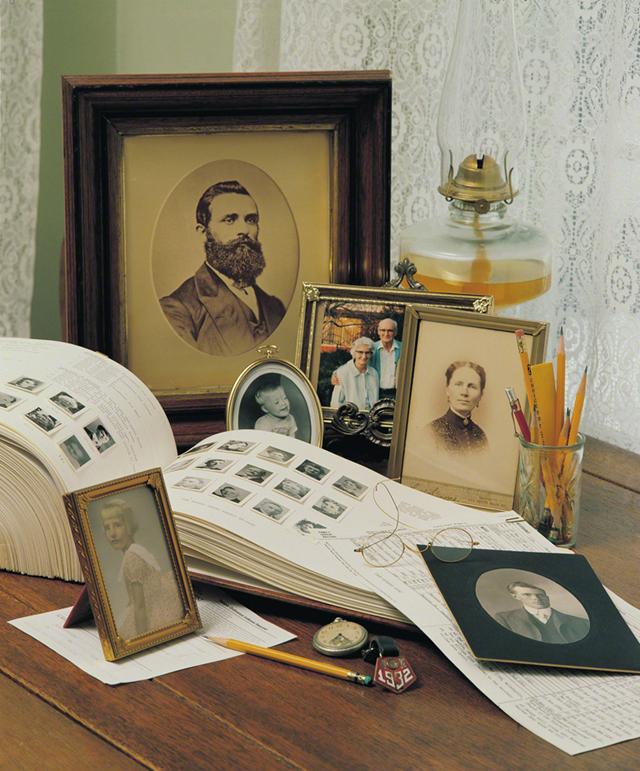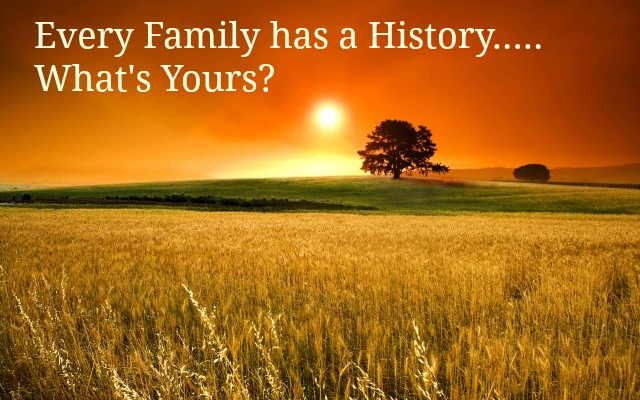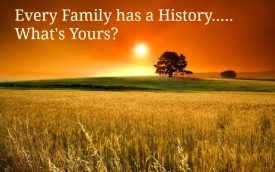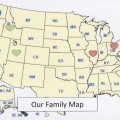I have gained knowledge about my family through conducting interviews of family members that I could not have found in any other source. Interviews can take several forms including a casual phone conversation. I enjoyed such a conversation recently with one of my aunts. I called to talk to her about her memories of my mother. My mom died way too young and before I was old enough to view her as being anyone besides my mom. My aunt has memories of the good times they shared as young adults and young mothers. The stories my aunt shared with me helped me know more fully the kind of person my mother was.
Family interviews can be conducted in a number of ways. When possible, an in-person interview is best because it allows the sharing of documents and photos. If you use Skype or other forms of video chat, consider using it as a substitute for a face-to-face conversation when distance is a problem. Along with the phone conversation I previously mentioned, email can also be used to gather information from family members. Whatever method of conducting an interview works best for you; you will what to do some preparing in advance. The following video shows two scenarios of the same interview and invites the viewer to note the differences between the two.
The most striking difference between the two scenarios is how much better prepared the granddaughter is in the second scenario. She has not only arranged the interview in advance but has also shared with her grandfather the information she is seeking and why. There are two other major differences. First, with the advanced notice, the grandfather is prepared and even looking forward to their meeting. It allows this conversation to be a bonding opportunity, bringing grandparent and grandchild closer together. Most people do like to share family stories. Many older people are flattered that someone wants to hear their stories. The other difference between the two scenarios is perhaps a bit more subtle but equally important. In the first scenario, the granddaughter asked closed questions that could be answered with a yes or a no. In the second scenario, she asked open-ended questions which invite answers that share more information. Here are examples of the two styles of questions:
In the first scenario, the granddaughter asks, “He and his wife had 3 children, right?” to which grandfather replies, “yes.” While in the second scenario, the granddaughter’s question was, “What can you tell me about his children?” Grandfather’s response was that there had been 3 children born during the second marriage and that there had been a daughter born during the first marriage. The open-ended question certainly invited the sharing of more information. The granddaughter learned of an additional marriage.
Now that is it clear how questions should be asked, what should you ask about? What follows is a list of suggestions that you should tailor to your family.
- Ask about the full names of spouse, children, siblings, parents and grandparents. Don’t assume what you have heard a family member called is the person’s given name. Some families use nicknames so consistently that sometimes they almost replace the given names. For example, my father was named Edward after his uncle and Thomas after his father, so the family called him Bud to avoid confusion. My father continued to use the name Bud throughout his life with my mother being one of the few people that I ever heard call him Ed. There were people after his funeral that said that my father’s eulogy was the first time they had heard his given names! And ask about the origins of nicknames which usually have a story behind them. One woman’s family still calls her “Thumper” because she kicked the sides of her bassinet in the newborn nursery!
- Ask about the birth dates and Places of family members
- Ask about death dates and places. Also burial places which may be different from the death place. When there is a difference, there may be a story as to why.
- What schools did family members attend?
- Ask about military service and if there is war memories the person would be comfortable in sharing. This can be a sensitive subject, even years after the occurrence.
- Ask about immigration of family members.
- Ask about the existence of journals or letters written by family members. Is there a family Bible with genealogical information recorded in it?
- Ask about religion and important spiritual experiences.
- Ask to see documents, certificates and photographs that the person has in their possession.
Last year, I had the opportunity to be the person being interviewed. The fourth grade teacher of one of my grandsons came up with an interactive project for her class to learn about recent history. She wanted them to hear from someone what life had been like for them fifty years ago. So she wrote a list of questions and invited her students to come up with a few of their own to add to her list. The students were assigned to ask the questions of someone who is between fifty and ninety years old. My grandson contacted me and asked me to participate. Since he lives several states away from me, his parents helped him email me the list of questions and I, in turn, responded by email. I enjoyed the opportunity to revisit those memories and the motivation to write about them. The questions for this project were a little different from the ones I have already listed, in that they focused on the differences between fifty years ago and today. These are some of the questions from the school project list:
- Tell me a little about your family background. What did your father do for a living?
- What was your first home you remember like? Did you have indoor plumbing and electricity? How was the house heated?
- What was your favorite childhood memory? How did children dress when you were little? I shared that little girls couldn’t wear pants to school when I was in elementary school.
- What were schools like in your youth? How far from school did you live? How did you get to school?
- What type of movies did you see? What was first car you remember like? I shared that before VCRs and DVDs we had to go to the theater or a drive-in movie to see a movie. I remember falling asleep in the back of station wagon at the drive-in movie.
- What problems were there in America that you remember? What wars do you remember? What major changes have taken place in the world that you remember?
My grandson added these additional questions;
- What was your favorite place to visit as a kid?
- What, if any, clubs or after school activities did you belong to and did you enjoy them?
- What was your favorite school?
- Name two hard things you had to deal with growing up.
I really like the nature of this teacher’s question because they helped my grandson see how my life had been different from his and how our experiences were similar. I am going to keep that thought in my mind as I do future interviews.
 And what about those photos and documents that may be shared with you during the interview? A digital camera, a cell phone or IPad could be used to capture copies but you need a steady hand or tri-pod to get a clear image. Fortunately, there are very portable scanners available that are reasonably inexpensive. Scanners wands are made by several companies in a range of prices. Powered by AA batteries, the wands are passed over the surface to be copied and a jpg image of it is captured. The image can then be transferred to a computer. More expensive but also more functional is the Flip-Pal which operates like a stationary scanner but is only 10 inches by 6.5 inches making it very portable. It too operates on AA batteries. To compensate for its small dimensions, it has the flexibility to be opened flat, so that larger items can be captured in multiple scans and then the scans combined using software on the Flip-Pal. Additional information on these portable scanners is readily available online.
And what about those photos and documents that may be shared with you during the interview? A digital camera, a cell phone or IPad could be used to capture copies but you need a steady hand or tri-pod to get a clear image. Fortunately, there are very portable scanners available that are reasonably inexpensive. Scanners wands are made by several companies in a range of prices. Powered by AA batteries, the wands are passed over the surface to be copied and a jpg image of it is captured. The image can then be transferred to a computer. More expensive but also more functional is the Flip-Pal which operates like a stationary scanner but is only 10 inches by 6.5 inches making it very portable. It too operates on AA batteries. To compensate for its small dimensions, it has the flexibility to be opened flat, so that larger items can be captured in multiple scans and then the scans combined using software on the Flip-Pal. Additional information on these portable scanners is readily available online.
The last piece of a successful interview is recording it. You can take notes but please do it on something other than the back of store receipt! The second scenario showed the use of a digital recorder. While digital recorder are becoming fairly inexpensive, if you have an IPad, IPhone, or Android phone, there are apps available to allow those devices to act as digital recorders. Recording the interview allows you to fully interact with the person you are interviewing instead of hurriedly taking notes, hoping you aren’t missing something. While you will want to transcribe the recording, be sure to save it in some permanent form. After that person has died, a recording of his or her voice will be something to be treasured. A video recording of the interview would also be a great but be sure to bring someone else along to run the video recorder. You will want to be able to focus on the conversation without the distraction of a camera between the two of you.
I have gained a greater appreciation for my ancestors from every interview I have done. The more I learn about my heritage, the closer I feel to my ancestors and the more I understand about myself.
Click here to watch a video called, “Courage: I Think I Get it From Him.”
In last week’s blog post, I encouraged you to look at sources in your home that contain genealogical information. Hopefully, interviewing family members will help you obtain more information about your family. The next step which I will write about is searching public records. Public records contain a wealth of information that can help you learn even more about your family.
About Christine Bell
Christine Bell has been seeking her ancestor for almost forty years and continues to find joy in each one she finds. She volunteers in a Family Search Family History Center where she helps others find their ancestors. As a convert to The Church of Jesus Christ of Latter-Saints, she is grateful to be a member of the Church. She is a wife, mother of six grown children, grandmother of five going on six, and currently living in the western United States. Christine enjoys spending time with family and creating quilts for family, friends and Humanitarian Services of The Church of Jesus Christ of Latter-day Saints.








Great article!
I was extremely interested in that book with all the pictures. That looks like an amazing project would love to see more of it.